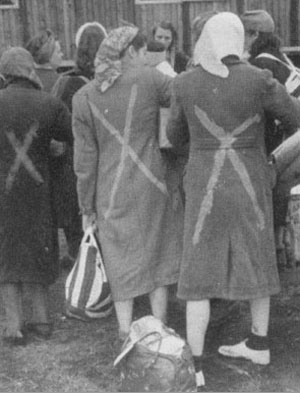

Click on the blue headlines to read background texts
Click on the questionmark (?) for info and orientation in the exhibition
Click on the grey arrow (<) to start the exhibition over again
Click on the grey arrow (>) to continue in the exhibition to artefact pictures

When World War II was drawing to its close in April 1945, the first ex-prisoners from the concentration camps began to arrive with the White Buses. Zygmunt Lakocinski immediately volunteered to translate. He learned that many of the women had taken with them original documents, which gave witness to the crimes and cruelties that the Nazis had done. Besides this, they also had with them small items which that they had made, been given, or found in the camps and had kept.
The authorities were afraid of contagious diseases and wanted to destroy all the clothes that the former prisoners had worn when they arrived. Lakocinski realized the historical value of saving these clothes and objects. Through contacts, he succeeded in saving a bunch of things from being burned. He also collected many personal items from former prisoners, and he even had help from the former prisoners. In this way, an exciting collection of artifacts grew, and a great portion is now at Kulturen in Lund.
Lakocinski also realized the importance of recording the personal testimonies of the former prisoners as soon as possible. Together with several colleagues, they made over 500 in-depth interviews to document the experiences of the former prisoners.
The interviews, which are now kept at the Lund University library, are unique in part because they were recorded so shortly after the arrival of former prisoners in Sweden, and in part, because the interview method that had been used was scientifically reliable. Lakocinski had help from Lund Historian Sture Bolin.
introduction
Ravensbrück, the camp
the White Buses
reception in Sweden
Lakocinski
collecting artifacts
the artifacts
Välj
bakgrundstexter med de blå rubrikerna.
Fortsätt till föremålsbilderna med den grå pilen (>).